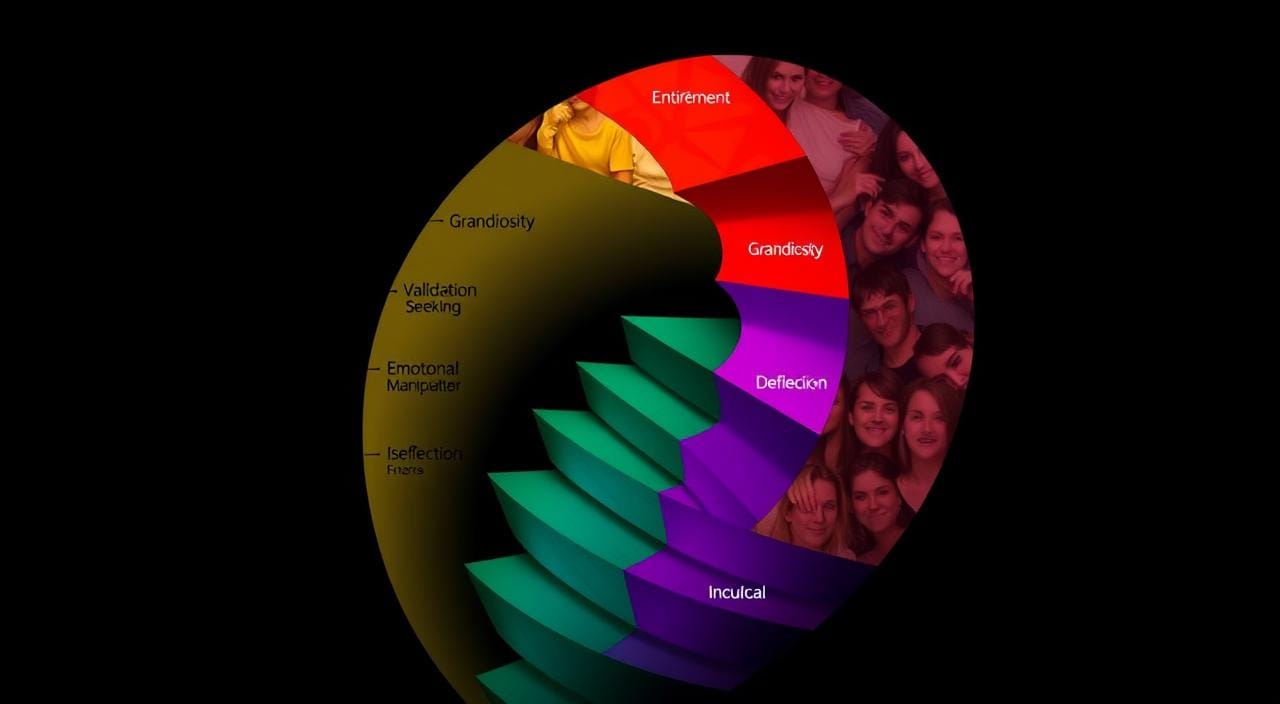Ending a marriage with a narcissistic partner seems impossible, but it’s crucial for your freedom. I’ve been through the pain of a toxic relationship with a narcissist. The longing and trauma bond make it hard to break free. But, this separation is key to healing and finding your self-worth.
We’ll look at strategies and mindset shifts for the no-contact journey. We’ll explore the psychological dynamics of narcissistic abuse and offer practical advice. 43% of people who’ve been with a narcissist find no contact helpful in healing1. We’re here to support you in this important step.
We’ll discuss co-parenting with a narcissist, setting boundaries, and building a support system. Those who’ve been abused by narcissists may face trauma bonding2. But, with the right mindset and tools, you can break free and start anew.
Key Takeaways
- Going no contact with a narcissist husband is a crucial step in breaking free from emotional abuse and regaining your sense of self.
- Maintaining boundaries and implementing strategies like parallel parenting and the gray rock method can help minimize the impact of narcissistic behavior.
- Healing from narcissistic abuse involves rebuilding self-esteem, creating a strong support system, and learning to emotionally detach from the narcissist.
- Recognizing the narcissist’s manipulation tactics and understanding the psychology of narcissism can empower you to make informed decisions about your well-being.
- With patience, self-compassion, and the right tools, you can break the trauma bond and create a fulfilling, narcissist-free future.
Understanding the No Contact Rule
Breaking free from a narcissist is tough, but the no contact rule helps you take back your life3. This rule means cutting off all contact, like phone calls, texts, and social media, with the narcissist3. It gives you space to heal from their abuse without their interference3.
What is the No Contact Rule?
Following the no contact rule takes dedication and discipline3. You must block their numbers and social media to cut ties4. Stay away from places where you might see them and be ready for “flying monkeys” – friends or family used by the narcissist4. If you have kids together, you’ll need to use parallel parenting and the gray rock technique to manage interactions4.
How to Go No Contact
4 Starting no contact is like quitting a bad habit – it’s tough at first but crucial for healing3. The narcissist might try to reach out in many ways, like showing up unexpectedly or sending gifts3. Leaving them can be hard and risky because they can’t handle rejection and want to control you3. They might try to win you back, make you feel guilty, use emotional blackmail, or discard you3.
3 Cutting ties can lead to feelings of loneliness, low self-confidence, and self-doubt3. It’s best to stick with the no contact rule forever to avoid more abuse and take back your life3.
“Going no contact is like quitting a heroin addiction – it’s painful, but necessary for your recovery.”
The Challenges of Going No Contact
Going no contact with a narcissist is tough because of trauma bonding and emotional addiction. The abuse, devaluation, and love cycles make you crave their attention, even when it’s bad5.
Quitting can feel like quitting an addiction. You might feel strong urges to contact them, especially when you’re feeling down5. It’s important to recognize this emotional tie and learn to handle the pain. This is key to breaking the toxic cycle and withdrawing from a narcissist5.
- Changing your view of a narcissistic/sociopathic partner takes time and usually happens while you’re being abused5.
- Leaving a narcissistic partner requires mental and physical preparation5.
- Psychological trauma can shrink parts of your brain, affecting your decisions5.
- It may take time to realize and act on the need to go no-contact in a narcissistic relationship5.
Going no contact is a big step, but it’s crucial for healing from the trauma of narcissistic abuse. Understanding trauma bonding and emotional addiction helps us prepare for the journey ahead. It helps us break free from the narcissist’s hold5.

Trauma Bonding and Emotional Addiction
The trauma bonding and emotional addiction in a narcissistic relationship make it hard to leave. The narcissist’s tactics, like gaslighting and love-bombing, create a strong emotional tie5. Breaking free needs a lot of strength and self-awareness5.
| Challenges of No Contact | Solutions |
|---|---|
| Trauma Bonding | Seek professional help, such as therapy, to address the psychological trauma and addiction. |
| Emotional Addiction | Develop healthy coping mechanisms, practice self-care, and build a strong support network. |
| Withdrawal Symptoms | Expect and be prepared for the intense emotional and physical withdrawal symptoms, and find ways to manage them. |
| Urge to Break No Contact | Resist the temptation to reach out, and remind yourself of the reasons for going no contact in the first place. |
“The path to healing from narcissistic abuse is not easy, but it’s necessary. By understanding the challenges and preparing ourselves, we can break free and reclaim our lives.”
Resisting the Urge to Break No Contact
Breaking free from a narcissist is tough, and wanting to reach out can feel strong. It’s normal to feel lonely and think about sometimes. But, it’s key to not give in to the urge to break the no-contact rule6.
Detaching from a narcissist takes time and goes through stages6. First, you realize they won’t give you the relationship you want. This leads to anger and resentment6. As you move forward, you focus on taking care of yourself, building emotional strength, and gaining independence6. Finally, reaching the end where you have no contact is a big win6.
The narcissist might try to emotionally hurt you or seek revenge when you leave6. They could speak badly about you, act like victims, or try to get back at you6. It’s important to stay strong and keep your focus on healing during this tough time.
“The no-contact rule is advised by most experts for dealing with a narcissist.”7
Healing is not a straight line. You might face setbacks like wanting the narcissist back or thinking wishfully7. But, with hard work and kindness to yourself, you can get past these feelings and move towards freedom.

It might be tempting to break the no-contact rule, but it’s important to resist. Keep your boundaries, focus on healing, and believe that with time, the loneliness and wishful thinking will fade. Your well-being and happiness depend on sticking to your no-contact promise to yourself67.
No Contact with a Narcissist Husband
Parallel Parenting and Gray Rock Method
Keeping no contact with a narcissist husband is tough when you have kids together8. You’ll need to use parallel parenting and the gray rock method. Parallel parenting means you only talk about the kids’ needs when necessary. You use a neutral person or an online calendar to plan things. And you don’t get into emotional talks or past issues8.
The gray rock method is about giving quick, uninterested answers. You don’t get drawn into their drama or games8. These methods help you keep your distance and avoid getting hurt. Narcissists might try to bother you by showing up at work or contacting your loved ones if you don’t reach out9.
- Communicate only the essential details about the children’s needs.
- Use a neutral third party or online calendar to coordinate schedules.
- Avoid emotional reactions or discussions about the past.
- Give short, disinterested responses to the narcissist.
- Refuse to engage in their drama or manipulation.
Parallel parenting and the gray rock method are good ways to deal with a narcissist husband while co-parenting8. By focusing on your health and setting clear limits, you can shield yourself and your kids from the harm a narcissist can cause.

“Narcissists require excessive admiration and may return after no contact to fulfill this need.” – Dr. Jennifer Jacobsen, Psychology PhD8
Remember, it’s hard to keep no contact with a narcissist husband. But with strategies like parallel parenting and the gray rock method, you can take back control. You can then focus on healing and improving your own life.
Healing from Narcissistic Abuse
Getting over the trauma of healing from narcissistic abuse is a big step. The narcissist’s constant put-downs and emotional games can really hurt your self-esteem and confidence. It’s key to get these back to live a healthy life without the narcissist10.
Rebuilding Self-Esteem and Confidence
Getting help from a professional can change everything. A Licensed Clinical Social Worker-Supervisor (LCSW-S) says that therapists trained in Cognitive Behavioral Therapy (CBT) can help a lot. They know how to deal with narcissistic abuse10. Also, setting clear boundaries is important to avoid going back to bad relationships10.
Having a strong support system is also crucial. Loved ones can offer compassion, distraction, and validation. These things help a lot in healing from narcissistic abuse10.
Self-care is also important. Activities like managing stress, sleeping well, eating right, and practicing mindfulness or yoga help a lot. Online Cognitive Behavioral Therapy (CBT) is also a good way to recover from narcissistic abuse10.
Healing from narcissistic abuse takes time, patience, and support. You need therapy, loved ones, support groups, and professional help for a long time10.
| Key Factors for Healing from Narcissistic Abuse | Impact |
|---|---|
| Seeking Professional Help | Provides specialized assistance from clinicians trained in Cognitive Behavioral Therapy (CBT) and personality disorders |
| Setting Boundaries | Prevents potential relapse into toxic relationships |
| Building a Support System | Fosters compassion, distraction, validation, and a sense of belonging |
| Engaging in Self-Care Practices | Promotes physical and emotional well-being |
| Cognitive Behavioral Therapy (CBT) | Effective therapeutic approach to address symptoms of anxiety, depression, and other mental health conditions |

“Healing from narcissistic abuse is a journey that requires self-compassion, patience, resilience, and the cultivation of a supportive environment through therapy, loved ones, support groups, and professional guidance for long-term healing and growth.”
Remember, the journey to rebuilding self-esteem after narcissistic abuse and regaining confidence after narcissistic abuse is tough. But with the right help and support, you can find yourself again and leave the narcissist behind10.
Emotional Detachment from a Narcissist
Achieving emotional detachment from a narcissist is key in the no-contact journey. Narcissists feed on our attention and emotional responses. Learning to stay calm and not react can be very powerful11.
Using deep breathing, mindfulness, and self-soothing can help calm you when they try to get a rise out of you12.
Be ready for their anger, smear campaigns, or attempts to pull you back in12. Staying firm in your decision and focusing on healing helps keep you emotionally distant11.
- Identify and address the emotional triggers that make it hard to let go of the narcissist11.
- Practice self-care and mindfulness to find inner peace and strength12.
- Surround yourself with supportive friends, family, or a therapist for emotional support11.
Remember, emotional detachment is not the same as emotional repression. It’s about responding with kindness, not reacting to their games12.
“The goal is to create enough emotional distance to reclaim your own power and identity, not to completely shut down your feelings.”
By creating this distance, you can move past a narcissist and handle their no-contact reaction well. This opens the door to your healing and growth1112.
Creating a Support System
Building a strong support system is key to successfully navigating the no contact process and healing from narcissistic13. We need to rely on trusted family, friends, and support groups. They offer a safe, judgment-free space to share our feelings and experiences13.
These connections help us feel less alone and lonely when we cut off contact with a narcissist13.
Leaning on Family and Friends
We should also look for therapy, support groups, or online communities focused on narcissistic abuse recovery13. Having a strong support network can greatly impact our journey to reclaim our lives13. It’s crucial to rebuild social connections and rely on family and friends after narcissistic abuse13.

As we build a support system after narcissistic abuse, remember healing is not a straight line14. Be patient and kind to yourself, letting healing happen at its own pace14. With the right support and resources, we can regain our power and live a life filled with joy and fulfillment14.
| Strategies for Building a Support System | Benefits |
|---|---|
|
|
“The most beautiful people we have known are those who have known defeat, known suffering, known struggle, known loss, and have found their way out of the depths. These persons have an appreciation, a sensitivity, and an understanding of life that fills them with compassion, gentleness, and a deep loving concern.” – Elisabeth Kübler-Ross
By rebuilding social connections after narcissistic abuse and relying on family and friends, we can face the no contact process with more resilience and hope13. With the help of our loved ones and professionals, we can take back our lives and come out stronger than ever13.
Recognizing Narcissistic Traits
Knowing the signs of narcissism is key to protecting ourselves in relationships. Narcissists often think they are more important than others, don’t care about feelings, and need constant praise15. They might use tricks like making you doubt yourself or controlling you to keep power16. Spotting these behaviors early helps us set boundaries and keep ourselves safe.
Narcissistic Personality Disorder (NPD) shows in many ways, like feeling entitled or not wanting to take blame17. People with NPD might find it hard to change, and therapy doesn’t always work for them15. Learning about narcissism helps us deal with tough relationships and focus on our own health.
Spotting narcissistic traits is a big step towards freedom. By understanding narcissism, we can make better choices for our relationships and health. With knowledge and kindness to ourselves, we can overcome these issues and aim for a better future.
FAQ
What is the no contact rule?
The no contact rule is a key strategy to break free from a narcissist. It means cutting off all communication, like phone calls, texts, and social media. This helps you heal from emotional abuse without the narcissist’s interference.
How do I implement the no contact rule?
To follow the no contact rule, you need to be committed and disciplined. Block the narcissist’s numbers and social media. Also, avoid places where you might see them. Be ready for attempts by “flying monkeys” – friends or family used by the narcissist.
How do I overcome the urge to break no contact?
Overcoming the urge to contact a narcissist is tough. It’s like quitting a drug. Recognize your emotional addiction and learn to handle the pain. This is key to breaking the toxic cycle.
How do I maintain no contact with a narcissist husband when we share children?
When you share children, use parallel parenting and the gray rock method. This limits contact and protects you. Communicate only about the children’s needs, use a neutral third party for schedules, and avoid emotional discussions.
How can I rebuild my self-esteem and confidence after narcissistic abuse?
Rebuilding your self-esteem and confidence is crucial. Seek therapy, practice self-care, and surround yourself with supportive people. With time and the right strategies, you can regain your sense of self and move on from the narcissist.
How can I build a strong support system during the no contact process?
Building a strong support system is vital for healing from narcissistic abuse. Lean on trusted family, friends, and support groups. Also, look for therapy, support groups, or online communities focused on narcissistic abuse recovery.
What are the hallmark traits of narcissism?
Narcissists have a grandiose sense of self and lack empathy. They crave constant admiration and are willing to exploit others. They may also gaslight and manipulate to control. Knowing these traits helps you spot toxic behavior and protect yourself.
Source Links
- How to go NO CONTACT with a Narcissist When You Have Children with One – https://leaveyournarcissist.com/2016/10/05/how-to-go-no-contact-with-a-narcissist-when-you-have-children-with-one/
- Is It Ever Okay To Break No Contact with A Narcissist? – https://medium.com/@katiabeeden/is-it-ever-okay-to-break-no-contact-with-a-narcissist-30fbf3f459ef
- Setting Boundaries With Narcissist: No Contact Rule – https://medium.com/psychology-self-healing/setting-boundaries-with-narcissist-no-contact-rule-b1b87e3a904c
- 7 Things Narcissists Do When You Go No Contact – https://www.linkedin.com/pulse/7-things-narcissists-do-when-you-go-contact-kamini-wood-hbfoe
- How to Deal with a Narcissist When You Can’t Go No Contact – Fairy Tale Shadows – https://fairytaleshadows.com/if-youre-having-trouble-going-no-contact-with-a-narcissist-try-doing-this/
- The Art of Detachment – Esteemology – https://esteemology.com/ending-a-relationship-with-a-narcissist-the-art-of-detachment/
- How To Get Over A Narcissist: 11 Essential Steps – https://www.mindbodygreen.com/articles/how-to-get-through-a-breakup-with-a-narcissist
- Do Narcissists Come Back After No Contact? – https://www.marriage.com/advice/mental-health/do-narcissists-come-back-after-no-contact/
- No Contact With A Narcissist – 7 Things Narcissists Do When You Go No Contact – https://www.bonobology.com/no-contact-narcissist/
- 7 Tips for Healing from Narcissistic Abuse — Talkspace – https://www.talkspace.com/mental-health/conditions/articles/narcissistic-abuse-recover-heal/
- The Stages of Changes It Takes to Leave a Narcissist — Phoenix Thriving Therapy – https://www.phoenixthrivingtherapy.com/blog/the-stages-of-changes-it-takes-to-leave-a-narcissist
- Navigating the Narcissistic Storm: The Grey Rock Method — Therapy With AB – https://www.therapywithab.com/blog/2023/12/23/navigating-the-narcissistic-storm-the-grey-rock-method
- How to Deal With a Narcissistic Husband: 5 Tips – https://www.btr.org/narcissistic-husband/
- How to Deal with a Narcissist: 10 Tools and Strategies to Help – https://www.healthline.com/health/how-to-deal-with-a-narcissist
- From the Spouse of a Narcissist: Here’s What You Need to Know – Tiny Buddha – https://tinybuddha.com/blog/from-the-spouse-of-a-narcissist-heres-what-you-need-to-know/
- Things Narcissists Say | Charlie Health – https://www.charliehealth.com/post/things-narcissists-say-in-an-argument-and-what-they-really-mean
- Signs You’re Married to a Narcissist – https://www.verywellmind.com/signs-you-re-married-to-a-narcissist-5208165







